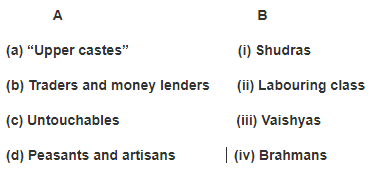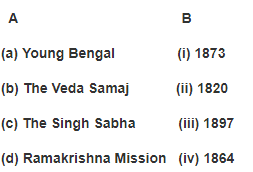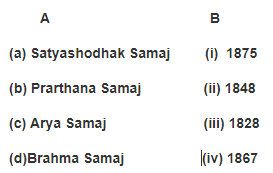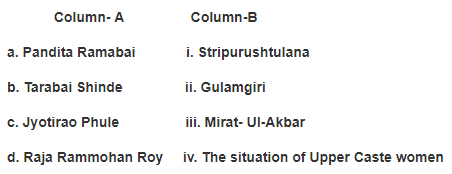Class 8 History Chapter 7 Practice Question Answers - Women, Caste and Reform
Q1. Read the following paragraph carefully –
In this popular festival devotees underwent a peculiar form of suffering as part of ritual worship. People pierced their skin & swung themselves on a wheel. In the early 19th century, when European officials began criticizing Indian customs & rituals as barbaric. This was one of the rituals that came under attack.
Q. Which festival is expressed in above paragraph –
(A) Hook swing festival
(B) Skin pierced festival
(C) Swinging festival
(D) none of these
Q2. Read the following statements –
1. British officials passed a law in 1856 permitting widow remarriage.
2. In the Telugu-speaking areas of Madras presidency Venctaman Raju formed an association for widow Remarriage.
3. In the north Swani Dayanand Saraswati also supported widow remarriage.
4. Ishwar chandra vidhyasagar used ancient texts to suggest that widow could marry also.
Q. Which of the above statements is/are incorrect in regarding to widows’ lives during 18th century –
(A) Only 1 (B) 1 & 2 (C) Only 2 (D) 2, 3
Q3. Which of the following works is/are not related to Raja Ram Mohan Roy –
1. He established Brahmo Samaj & protested sati system.
2. He published ‘Sambad Karmudi’ & ‘Mirat-ul-Akbar’.
3. He used ancient sacred texts to support his point of view.
4. He began a campaign to protest female foeticide.
(A) Only 1 (B) Only 2 (C) Only 3 (D) Only 4
Q 4. The first educational institution which provide girls with the kind of learning that was usual for boys at the time –
(A) Sakhwat Memorial School
(B) Hindu Mahila Vidhyala
(C) Calcutta Mahila Mahavidhyala
(D) Mukti Mission
Q5. Read the following statements carefully –
(1) She was educated at home at Poona
(2) She wrote a book “Stripurushtulna”
(3) In her book she criticised the social differenes between men & women.
Which famous personality is better expressed in the above statements–
(A) Pandita Ramabai
(B) Tarabai Shinde
(C) Begun Rokeya Sakhawat Hossain
(D) Mumtaz Ali
Q6. In which year the child marriage restraint act was passed –
(A) 1928 (B) 1929 (C) 1930 (D) 1931
Q7. Some statements are given below :
(1) Raja Rammohan Roy translated an old Buddhist text that was critical of caste.
(2) The Prarthana Samaj adhered to the tradition of Bhakti that believed in spiritual equality of all castes
(3) In Bombay, the Paramhans mandali was founded in 1840 to work for the abolition of caste
(4) Christian missionaries began to set up schools for tribal groups & lower caste
Q- Which of the above statements is/are true regarding caste system in 19th century –
(A) Only 1 (B) 2 & 3 (C) 2, 3, 4 (D) All of these
Q8. Assertion : In 10th century the poor began leaving their villages to look for jobs.
Reason : The expansion of cities created new demands of labour in factories & Municipalities.
(A) Both (A) & (R) are right & (R) is the right explanation of (A)
(B) Both (A) & (R) are right but (R) is not the right explanation of (A)
(C) (A) is right but (R) is false
(D) (R) is right but (A) is false
Q9. Name the coolie ship which carried many Indian labourers to Mauritius where they did a variety of forms of hard labours-
(A) John Allen
(B) Potter ship
(C) John Potter
(D) None of these
Q10. Read the following statements.
(1) He was born in 1827 & studied in schools set up by christion mission aries.
(2) He set out to attack the ‘Brahmans’ claim that they were superior to others.
(3) According to him the “upper” castes had no right to their land & power.
(4) He proposed that shudras (labouring castes) & Ati shudras should unite to challenge caste discrimination
Q. Which of the following reformer is related to above statements –
(A) Shri Narayan guru
(B) Jyotirao phule
(C) Dayanand Saraswati
(D) Veerasalingm Pantulu
Q 11. Read the following Statements carefully-
1. In 1873 Phule wrote a book named ‘Gulamgiri’ meaning slavery.
2. Phule dedicated to this book to those Americans who had fought to free slaves
3. Through this book, he established a link between the condition of lower caste in India & the black slowes in America.
4. He said that Brahmanas were superior & had rights on land.
Which one of the following statements is/are not related to Jyoti Rao Phule -
(A) Only 1 (B) Only 2 (C) Only 3 (D) Only 4
Q 12. Which of the following statement is not related to Singh Sabha movement
(A) It was the Reform Organisation of Sikhs.
(B) The First Singh Sabha was established in 1873.
(C) The Second Singh Sabha was established in 1875.
(D) The Sabhas sought to rid Sikhism of Superstitions,caste distinctions and Practices seen by them as Non-Sikhs
Q 13. Match the following

(A) a (ii) b (iii) c (iv) d (i) (B) a (i) b (ii) c (iii) d (i)
(C) a (iv) b (iii) c (i) d (ii) (D) a (iii) b (ii) c (i) d (iv)
Q 14. Who among the following women reformers supported women’s education by reinterpreting the Kuran in support of her arguments ?
(A) Banu Begum
(B) Shabna Azmi
(C) Mumtaz Ali
(D) Regina Begum
Q15. Match the following

(A) a (iv) b (iii) c (ii) d (i)
(B) a (ii) b (iv) c (i) d (iii)
(C) a (i) b (ii) c (iii) d (iv)
(D) a (iii) b (ii) c (i) d (iv)
Q 16. Match the following-

(A) a (iv) b (iii) c (ii) d (i)
(B) a (ii) b (iv) c (i) d (iii)
(C) a (i) b (ii) c (iii) d (iv)
(D) a (iii) b (ii) c (i) d (iv)
Q17. Which Statement is/are not true regarding “Sati System”
1. It was abolished by “William Bentick”
2. It was banned in 1829.
3. Raja Rammohan Roy described sati system as “Murder according to every Shashtra”
4. Sati means “Virtuous Woman”
(A) only 1 (B) Only 2 (C) Only 3 (D) None of these
Q 18. Read the following statements carefully-
(1) Rajaram Mohan Roy was well versed in Sanskrit, Persian and several other Indian and European language.
(2) He tried to show through his writings that the practice of widow burning had no sanction in ancient texts.
(3) British officials did not begin to criticise Indian tradition and Customs.
(4) Raja Rammohan Roy was keen to spread the knowledge of western education in country.
Which one of the above statements is/are incorrect-
(A) 1 and 3 (B) 3 and 4 (C) Only 3 (D) Only 4
Q 19. “Isn’t a woman’s life as dear to her as yours is to you? It is as if women are meant to be made of something different from men altogether, made from dust from earth or rock or rusted iron whereas You and Your lives are made from the purest gold”-
Who wrote this statement and in which book-
(A) Tarabai Shinde, Stripurushtulna
(B) Pandita Ramabai, The situation of Upper Caste Women
(C) Begum Rokeya Sakhawat, Sultana’s Dream
(D) Raja Rammohan Roy, Sambad Kaumudi
Q 20. Match the following-

(A) a (ii), b (iii) , c (iv), d (i)
(B) a (i) , b (ii) ,c (iii) ,d (iv)
(C) a (iv), b (i) , c (ii) , d (iii)
(D) a (i) ,b (ii) ,c (iv) ,d (iii)
ANSWERS -
Q.1.(A) Q.2.(C) Q.3.(D) Q.4.(B) Q.5.(B)
Q.6.(B) Q.7.(D) Q.8.(A) Q.9.(A) Q.10.(B)
Q.11.(D) Q.12.(C) Q.13.(C) Q.14.(A) Q.15.(B)
Q.16.(B) Q.17.(D) Q.18.(C) Q.19.(A) Q.20.(C)
|
69 videos|431 docs|46 tests
|
FAQs on Class 8 History Chapter 7 Practice Question Answers - Women, Caste and Reform
| 1. What is the significance of women in the caste system? |  |
| 2. How did the reform movements in India impact women? |  |
| 3. Who were the prominent women leaders of the Indian reform movements? |  |
| 4. What were the challenges faced by women in the Indian reform movements? |  |
| 5. What is the current status of women in India in terms of caste and reform? |  |






















